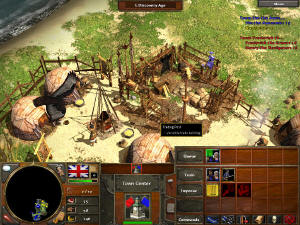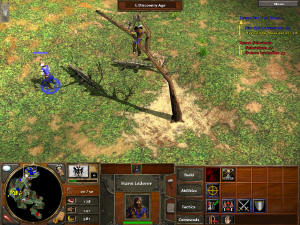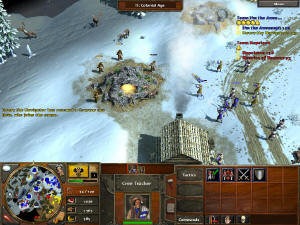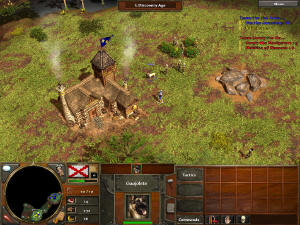|
|
||||||||
EXPLORING FOR THE AGES THE EXTRA ROLES OF EXPLORERS IN AGE OF EMPIRES III
Microsoft’s Age of Empires series of computer games, along with their
space opera incarnation Star Wars Galactic Battlegrounds (Lucasarts)
has had two opposite and equal effects on schedules for years. One is
providing many hours of enjoyment to real-time strategy [RTS] computer game
enthusiasts. The other is killing just as many hours of otherwise productive
time that might have been spent on something other than playing RTS games to
all hours of the day and night. EXPLORER OF THE NEW WORLD
Explorers obviously explore. This is the first mission of the unit, and one that it performs better than the mounted scouts of Age of Empires II. This game’s explorers may not be portrayed as having horses, but they do have good mobility, and survivability is not much of a problem early in the game. There are exceptions, such as when a computer-controlled French pathfinder picked a fight with my English explorer, who beat a fighting retreat for the town center. There five colonists joined the fight and helped arrange a meeting between the unfortunate Frenchman and his God. In the hands of a careful human player though, the unit has little to fear from such tricks. In the early stages of the game, the Discovery Age especially, there are seldom any military units on the map, and the only armed opposition is going to come from the explorer’s counterparts and civilian colonists. With that in mind, the player can have his explorer run into an opponent’s colony, take a look, and run out, without much danger, as long as he dares not to linger. In many games too, a player will have help. This can be from helpful Native American volunteers, who either start the game with the player or join following rescue from some peril. These Indians do not have any of the extra capabilities of European explorers, but the extra pair of eyes early in the game can be valuable. Less frequently, one has animals to help out too. Depending on the map environment, Age of Empires III sometimes allows for training “Buttercup the Cougar” and other mountain lions to fight alongside two-legged friends, and tame bears can be rescued similarly to Indians chased up trees by hungry grizzlies (historical wargame purists, your distress is noted). In addition, some games give players scout dogs, which function similarly to their Native American counterparts.
In any event, the need to scout
passes, and so does the usefulness of such weird units. However, the European
explorer adapts to changing needs. ASSET SEARCH AND SEIZUREOne of those extra jobs is picking up the treasures laying about the map. They take a variety of forms, including the expected gold caches, exotic foods and stacks of local wood. Some are more arcane, such as the skunks that grant experience points. Native Americans can be cornered or, more commonly driven up trees, and upon rescue will join one’s side. A few treasures are “power-ups” that enhance the capabilities and survivability of one unit, usually the explorer himself. One particularly valuable prize is a prefabricated fortification, disassembled and sitting in a wagon, ready to be taken anywhere and setup at no cost in resources or labor. Explorers are not the only units that can take treasures, and if colonists are nearby they are the logical choice to do the job. But in the beginning they are unlikely to be either plentiful or widespread, and the wide-ranging explorer is the unit that will get there first. Most of the time too, the most valuable treasures will not be simply laying on the ground, ready for any passerby to pick them up. Most are guarded by either nasty animals for nasty people, desperadoes, bandits or pirates of some variety. All will mind their own business if the player leaves them alone, but in order to take possession of a treasure, they have to be eliminated in combat. Many are far from pushovers, and the better the prize, generally the stronger the opposition. Quite often, a player’s only option is to leave them alone for later, when he has army to challenge them. That is no overstatement; when the guardians consist of four of five strong units with big guns, it makes sense to bring ten of one’s own to the battle. The explorer can help out, but his most important role will be to pick up the treasure from under the pile of bodies. There are other times, and not necessarily a few of them, in which the explorer can handle things on his own, or maybe with one or two colonists to help out. If there is just one guardian, he should always go for it himself, without waiting for backup. That is because of one of the special capabilities added to this installment of the series, one that beginning players might miss, but experience teaches is extremely valuable. Explorers have the power to kill any treasure guardian with one shot, with no response possible, no matter how tough they might be in conventional combat. Thus, if a treasure has one guardian, it might has well have none if an explorer is around. The downside is that it takes time for the one shot, one kill capability to recharge, and in the meantime the dead animal or malefactor’s friends are going to be extremely angry. If an explorer can kill one wolf or alligator and leave one to fight in the usual manner, then the first shot evens the odds, and the man might take some wounds, but he stands a good chance of getting out with both the treasure and his life. However, should he kill one of five bears or bandits, then it just means a certain death at the hands at the other four. INDIAN AGENTMany players will miss the opportunity to play as the Aztecs, Maya, Iroquois, or other Natives, represented either in the fully expanded versions of Age of Empires II or its closely related cousin, Rise of Nations (Microsoft). Their absence as active participants owes much to this game’s portrayal of the Indians as peoples to be sought as allies more than fought as enemies, or even as players in the fate of their own continent. There is no parallel for Cortes seeking out and destroying the Aztecs, or the constant jockeying between Algonquin, Iroquois, French and British in North America. Like it or not, this New World is a white man’s world. Trading posts are essential to dealing with the Indians, and are built by either colonists or explorers. Once again, it is the latter who are more likely to get to the objective first and establish a presence before the enemy, and sometimes before one’s own European allies. Mobility like rank has its privileges. Age of Empires-series and Rise of Nations veterans are already familiar with the phenomenon of accumulating resources by setting up trade between markets. Age of Empires III differs in that the trade routes are already established when the Europeans arrive, divorced from market places, with three or four possible sites for market places plotted on the map. The Indians are already trading between them via travois; by putting up his own posts, the player can gain experience points, then more tangible resources when progress permits him to improve the trails to stagecoach routes and then railroads. Thus the First Nations already have the basic lines of commerce plotted before the game; it takes an explorer to find them and often to exploit them. Indian warriors function as auxiliaries to the European military forces, contributing warriors that do not count against a side’s population limits. They also tend to cost less. Finally, Indian alliances can give the Europeans special knowledge, including the ever-popular “Buttercup the Cougar” rule, and more immediate and believable capabilities such as horse breeding and faster construction. It does pay to listen to the locals. The same kind of trading posts that tap trade routes cement Indian alliances when placed on aboriginal towns instead. There is no mechanism for diplomacy or tribute or appeals to reason; one builds a trading posts, and makes an alliance, so making friends is a matter of having a sufficient supply of wood and a colonist, or more likely an explorer, in the right place the right time. TOWN FATHERThe final major role for the explorer is as the founder of new settlements. In previous installments of the series, any peasant could build a town center, as it could construct any other building. In Age of Empires III, the means are much more limited. One way is to bring it over from Europe, in a wagon. This is also the only way to build a fort, only one of which will be on the map for each side. The advantage of this is that any such asset shipped from the old country takes up shipping space but does not require local resources or labor to build. From the Fortress Age, that is the third one in the game, onward, the explorer can also expend resources to build town centers. He has a monopoly on this power, and can erect at most two in the course of the game. At the same time, there is less call for multiple settlements than there is in the other titles. Granted, one can train colonists at multiple locations, or transition to a new age at one town while receiving colonists at another, and there is the experience point benefit of constructing major works. After all, there are no wonders or castles in this game, so town centers and that one fort are about the most impressive buildings that one is going to put on the ground. Ultimately, placing a town center on the map is more about placing one’s footprint on the continent as it is about any concrete economic or military power. That is a task for the explorer, and it is one that can be performed only late in the game. It is one more reason to keep him alive and functional, as though the player needed another. CONCLUSIONSOne should not play Age of Empires III as though it is The Age of Kings with muskets and better cannon. As the trade mechanics and the availability of support from Europe demonstrate, the economics that underpin any RTS game have some fundamental differences, while retaining much of the familiar theory and practice. Militarily, there is a surprising change in that military units are not automatically upgraded with the passage to a new age, so a side could have medieval pikemen and crossbows fighting alongside the kinds of musketeers and grenadiers who fought under Montcalm, Wolfe or Washington. There is a lot more room for anachronism and a smart player has to be careful not to lead yesterday’s army into tomorrow’s battle. These differences are obvious upon the first play. So too is the fact that one will not fight any Indians unless they are being brought into action by another European power; like the treasure guardians, Indians will remain passive if left to their own devices. Less readily apparent is the enhanced value of the explorer. No mere disposable scout, this unit is as vital as the player wants it to be, a combination reconnaissance specialist, special forces operator, political agent, and acquirer of rare goods. The recon role fades in value as the game goes on, but the other roles actually increase in importance with the passage of time. A wise player keeps one eye on his explorer throughout the game, keeps him alive, and if he is not continually active, he is available to do something. A successful game will end with the player’s conventional troops and artillery swarming over the enemy’s town, generally hurting people and breaking things until the opposition is either eliminated or induced to surrender. When that happens, a victory should also include a live, accomplished explorer. SCREEN CAPTURES |





